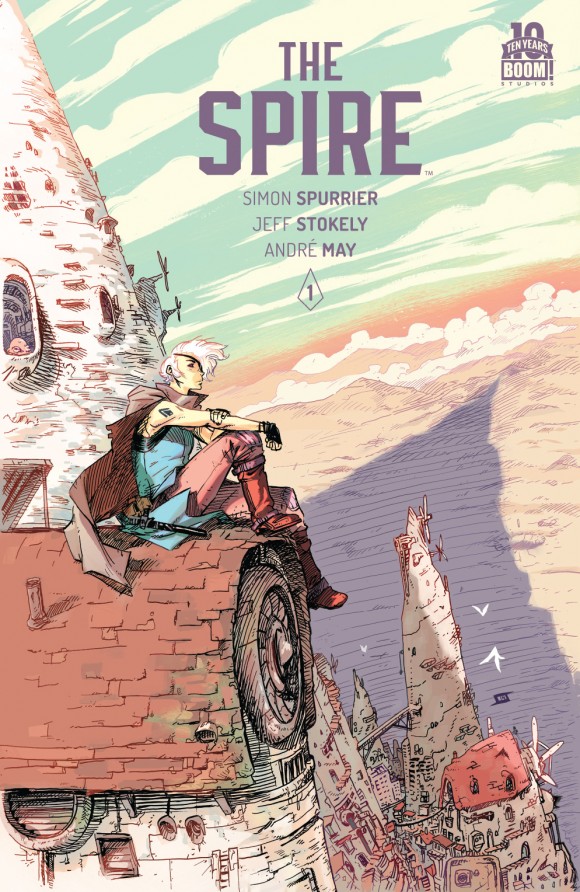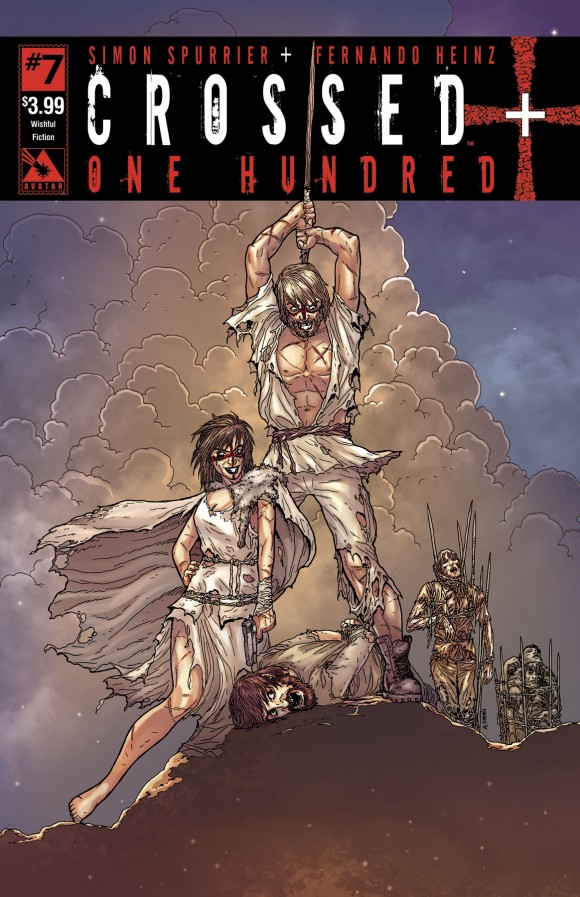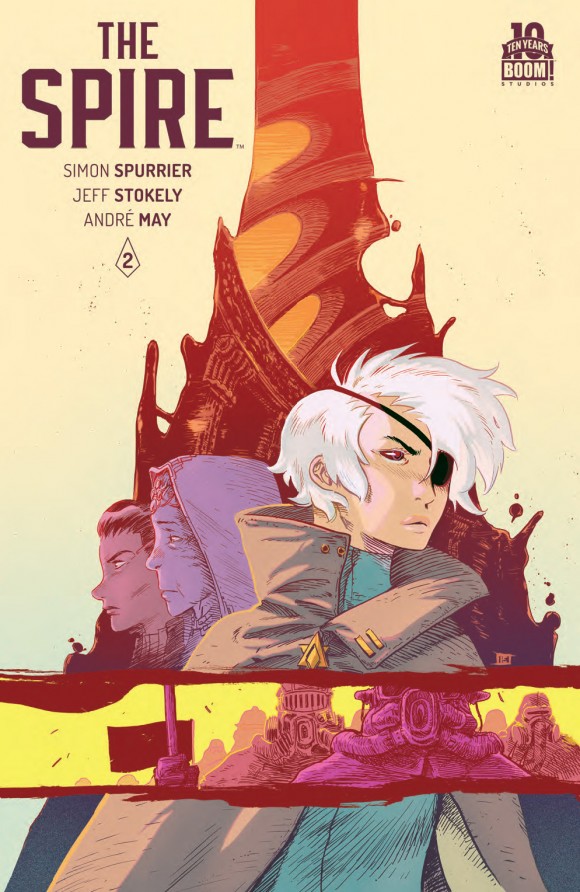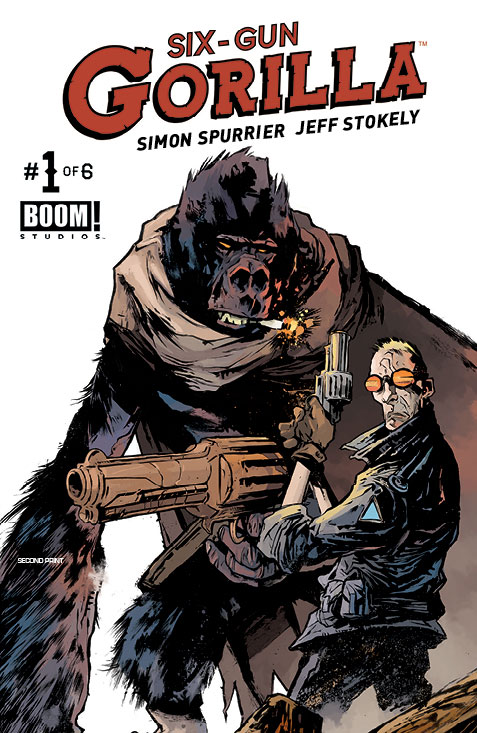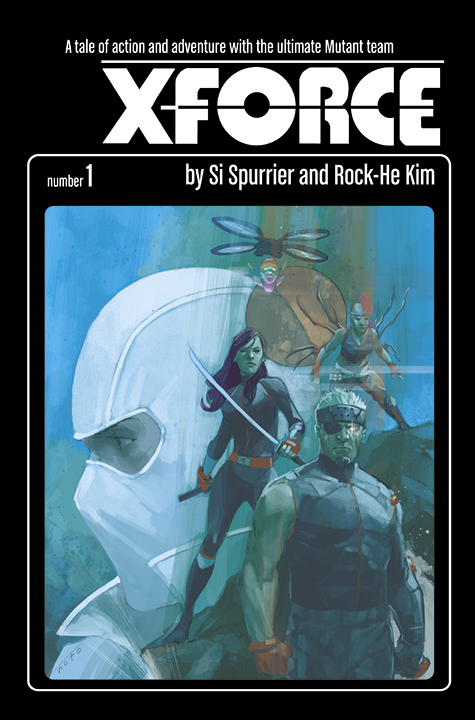We sat down with Simon Spurrier to talk about life, the universe and everything (mostly comic books).
In the first part of a two-part interview, Si talks The Spire, Crossed and assorted miscellany.
By G.D KENNEDY
Simon “Si” Spurrier is nothing short of ubiquitous these days, writing The Spire, Crossed +100, Dr. Who, and the forthcoming Cry Havoc from Image, while wrapping up titles like Disenchanted and X-Force. Being busy is a good thing, however, particularly given that Si is facing a self-imposed career crossroads, as he has actively shifted his focus from the large serialized books for the likes of Marvel in which he’s built a strong and stable reputation, and turned towards the more volatile world of creator owned works with publishers like Boom!, Avatar, and Image. The early returns are promising, as The Spire has been one of the most fascinating books of the past year, with Si teaming back up with his Six Gun Gorilla cohort Jeff Stokely, while his work on a Crossed one-shot, Wish You Were Here, was enough to convince luminary and noted curmudgeon Alan Moore to turn the reins of Crossed +100 over to Spurrier.
Si travelled in from London for this year’s New York Comic Con, and we managed to meet up on the fourth day. If you’ve never attended the full four-day affair, it is an exhausting experience, for fans, exhibitors, creators and press alike, and by the last day, the body is sore from walking across concrete floor, screaming for food from somewhere other than the food court, and aching for sunlight. When we met up on Sunday, Si was shaking off the rust from a late evening with some of his more infamous colleagues, so we opted to sit outside on some of the steps off the back of the Javits center, taking in a few minutes of sunlight, until we were summarily kicked off of said steps which were, apparently, off limits.
Regardless, Si spent time talking about a range of topics, from ruminating on the books he’s currently working on, to talking creative process, and his rituals as a writer, all of which sounded evenmore erudite and calming when heard in his effortlessly charming British accent. Below is the first part of the interview with Si, in which we talk about Crossed, the Spire, and, more or less, life, the universe and everything. Part 2 covers his forthcoming title Cry Havoc, along with a PREVIEW of the book’s first issue.
***
G.D. Kennedy: So I just had the horrible experience of having my recorded shut off in the middle of an interview . . . .
Simon Spurrier: The first interview I ever did as a published writer when I was working at 2000 A.D., the interview has actually become a friend of mine, since then, he came all the way down to London where I lived and we sat and did an interview for five hours. It was supposed to be this gonzo thing. I took him out, we got drunk, it was supposed to be this really good interview and it was just unusable, the sound was really bad and he ended up scrambling it when he got home anyways.
G.D. Kennedy: Makes you wonder how Hunter Thompson ever got anything . . .
Si: He made it all up, I suppose.
G.D.: You have a lot of books that have been coming out recently –
Si: It’s been a busy year.
G.D.: You’ve been all over the place. The X-books have wrapped, Spire, Disenchanted, Cry Havoc. Am I missing anything?
Si: Dr. Who. And the stuff I do for Avatar. Disenchanted wrapped, and I’m doing Crossed +100, which is the Alan Moore book, which is amazingly difficult but good I think. Before Disenchanted, I did the [Crossed] web comic for Avatar, called Wish You Were Here, and I sort of felt like I had said everything I had to say about the Crossed world and it’s not a fun thing to write. I stand by it. I think it’s solid work. But it’s tiring and emotionally draining to write that sort of horror, and then of course, Alan comes along and says [breaking into a baritone], “Si, I’d really like you to do Crossed,” and you can’t exactly say “No.” So yeah, it’s been great and he’s been lovely to me and put a lot of faith in me.
But yeah, it’s hard. In his first six issues, he created this whole new language. I’ve taken to calling it post-post apocalyptic. It’s one hundred years after the dreadful event that wiped out most of the world and he proposes that in the hundred years since then, language will of course slightly change. There’s all of these wonderful contractions. For instance, people say, instead of “What do you think” or “Hey,” they say “AFAWK,” which is “As far as we know.” Because they are so used to saying, “It’s the 13th of July, AFAWK.” They don’t really have any way of knowing. All sorts of stuff like that. It required me to learn this language and evolve it and change it. So it’s really hard stuff, but I think it’s good.
G.D.: Is horror something you find difficult to write?
Si: No, I enjoy it. It’s difficult when – some of the places crossed goes, especially.
G.D.: It’s a dark book.
Si: It’s a very dark book, and I think especially, some of the arcs written by other writers – everybody has their own boundary for what is valuable horror and what is gratuitous horror. And some of the other books step over my personal line, but everybody has their own personal metric for that stuff.
Part of the privilege of writing comics is that you can be working on five different books. I like doing horror. I thought I had done everything I had to do in Crossed, but it’s nice to go back.
G.D.: What are you discovering new that you have to do there that you didn’t do before?
Si: It’s such a different book. It’s still hard writing about violence and sexual violence in particular, and all of those sort of dark – the rule for myself which I have evolved somewhat since working on Crossed, but I think this is true of all work, is if you are going to depict violence, then the scene can only be about violence.
This is especially true if you’re going to depict sexual violence, then the scene can only be about sexual violence. It follows that if you’re using sexual violence for any reason other than to say that sexual violence happens and it’s really fucking horrible then – just don’t. Because it’s not something that you need to be a character thing. It doesn’t need to be a plot point. And, you know, naming no names, there are people out there, writers who have gone on record saying, “I see no problem with rape because it’s the last taboo, and that’s what we are supposed to do, break the last taboo,” and “How else are you supposed to show your villain is a bad guy unless he rapes someone?” And that’s just lazy thinking.
G.D.: It’s very easy.
Si: Yeah. So there are people who read my Crossed work and will be horrified. They will say, “There is gratuitous sexual violence.” Everybody has there own line. I think I can justify everything that I’ve done for myself, but that doesn’t make it easy. It makes it difficult to write, and difficult to have to have these conversations with myself constantly while I’m writing.
G.D.: Moving to more upbeat books, Spire – it may be upbeat, at least a little less dark. This is your 8-part series at Boom! It’s had a great mix of a Nausicaa-type feel –
Si: In fact, before Jeff [Stokely] started it, I got him on to Nausicaa. You can see that in some of his designs. That wonderful [Hiyaoa Miyazaki thing that he’s started picking up.
G.D.: His artwork is a hybrid of Miyazaki meets Moebius.
Si: A lot of people have been saying that.
G.D.: Where did Spire come from?
Si: Weirdly enough, the idea in a very different form arose ten years ago. I was a film production student at university, and my major project was a screenplay, which was the Spire. And it was utterly different. There was almost no relationship, except that it was about – it doesn’t matter what that one was about, it matters what the new one is about. I honestly couldn’t tell you where the things that in-Spire-d – Oh, that’s clever. I’m sorry, that’s terrible.
When I sat down to write it with Boom!, it happened to coincide with a lot of conversations in the world about immigration and population change and this general bloody discourse about how easy it is to take power by making people afraid of other people. There is no simpler power than to work people up and say, “Oooh, there’s people who aren’t like you coming to take your job and coming to take your wife,” and all that bullshit, and I hate that stuff. So, I wanted to do a story that touched on those things.
The story isn’t really about that, it’s just one of the things going on in the background. What’s quite nice about the Spire is that in all respects, it’s a big thing. It’s a whole new world, Jeff and I created this world, we thought about it a lot, we can explain what everything is, where everything goes, who all these characters are, and these non-human characters, we know all of their histories. But we’re not interested in telling anybody about that. What we said we were going to do was put a lot of energy into creating this world, and then we are going to ignore it and tell quite a small story in some ways. It’s not really a small story – it starts small, and then it becomes a conspiracy and all sorts of interesting stuff grows from it.
But we really used Blade Runner as out kind of narrative touchstone in the sense that they’d done exactly the same. They created this incredible world that you want to spend time in, but the story itself doesn’t have world-changing stakes. And I think there’s this lazy conventional wisdom that if you create a world, the story has to have world-changing stakes. There’s a little bit of that going on in the Spire – there’s a conspiracy and things get quite epic, but it’s not that story. It’s the story about a woman trying to solve a murder, and investigating a mystery about herself, and that’s great. I don’t think I’ve ever seen an investigative story before where the investigator is looking into their own life, their own past. That’s kind of fascinating to me.
G.D.: I thought that was one of the interesting things about it. It’s such a fully rendered world. But you really only play with that on the edges and give us hints of that. What was the decision behind this? Why was that so important?
Si: It just felt honest. I just think if you’re going to – if you claim to be a storyteller, the most important thing is that your readers are resonating with the story, and the story is resonating with the reader. If you make the story about newness, about this whole new crazy world, and “look at us, aren’t we inventive and creative,” then it’s inventive and creative but there’s no way your readers are going to give a crap because it’s completely detached from reality. It’s completely detached from the things that matter to them.
So the secret for me was quite simply to have fun making this world, and to make it unlike anything else. And hey, we’re not stupid. We know that the selling point of the Spire is that it’s an incredible new world, and they look at it and see Jeff’s art and say, “This is an amazing world! I want to read this.” But, the truth is that it is the story of a woman, and if that woman isn’t able to – if her character isn’t something the readers can’t respond, if they can’t see something of themselves in her and the other characters in the book, then we’re doomed. There’s no point in telling that story.
G.D.: I think one of the other interesting elements is the xenophobia element is important, but so often when we deal with that, it is front and center to the plot. You look at God Love, Man Kills for the X-Men, and it is “Muties Die!” This isn’t that; rather, what you present is almost an unfortunately accepted fact of life that feels almost more true. Why approach from this direction?
Si: I feel that the debate – it’s not even a debate, it’s pricks being pricks. I think the problem is xenophobia, racism, in particular, and specifically, without splitting hairs, I would say the allegory of the Spire is more about immigration than it is about race. I think it’s far more nuanced than we would like to believe. I think it’s nice and easy and comfortable and convenient for us to say, “Racism is bad,” and “Anybody who is racist is all-out racist,” and they will waive signs that say, “Muties Out!” and all the rest of it.
And that’s not my experience at all. My experience is that people pride themselves on being progressive and living in a society built on mix demographics, but when you get right down to it, at the coalface, they would like to be surrounding by people like them than people who aren’t like them. And that’s a really difficult reality and an ugly reality, and I think you find those people out quite easily, but not just by asking them, “Are you racist?” “No, of course not.”
G.D.: It’s not normally a conversation starter.
Si: It’s actually how I hit on people.
G.D.: Immigration is very much in the forefront now, and I think since Spire came out, it’s spiked even more. Is this changing the way you’re telling the story? Is there anything you would want to add?
Si: It is the most responsive thing I’ve ever written, but that is more to do with Jeff than me. This is the first story I’ve written in a very long time where I deliberately leave gaps in my script knowing that Jeff will come in and do something wonderful with it. And that comes from the two of us having become friends, and having worked on a book, Six Gun Gorilla, when we didn’t know each other at all. He quickly convinced me that what I told him to do, he would always make it better than I had imagined it would be. And that’s – for me, that’s the simple test of if you’re working with a good artist. If you can remember how you imagined a page when you wrote when you see the final art, then the art is not succeeding. And 9 times out of 10, you can’t remember the page.
With Jeff, I have no fucking idea what I must have been thinking when I wrote those pages. And it’s nice to be able to say, “Sha’s walking through part of the city. There’s some technology around her. I don’t really know the technology is – is it magic? Is it clockwork? Is it furnaces? Jeff, you tell me.” And then once he’s decided what that’s going to be, I might use that later on as a plot point. I’ll say, “She’s meeting a character, somebody who’s not human. You tell me what that look’s like.”
In the first episode, Sha meets this wonderful guy – Jeff did such a great job – his name is Mr. Wud. Having seen the way Jeff drew him, I’ve decided he’s a living mollusk of some sort, what looks like face is actually his shell, and what looks like a body is actually the tongue of the mollusk, and he’s this huge thing that sort of shambles around. And when Jeff drew it, we decided it would be fun if he had little eyes stuck on the front of his shell, because he’s realized the people around him are already suspicious of him, there’s all these prejudiced people, and the only way they’ll deal with him is if they think they can make eye contact with him, so he sticks on these little eyes. And that’s become a bit of a plot point for later on in the story. There’s a whole thing that hinges around the fact that you can get ahold of these little false eyes. There’s just cool stuff like that.
It means you can keep changing up what you’re doing, whether or not I am responding to real world events – I don’t know. I don’t think so. Not because I can’t, but because it was pretty clear that when we set out to make this story that the world was pretty full of people, unfortunately, who are not very nice, and who are very good at being afraid of people not like themselves. Even more unfortunately, the world is very full of people who are willing and able to manipulate that to get what they want. And that’s kind of the story at the heart of the Spire – it’s about people using fear and intolerance to achieve their own goals.
G.D.: So you mentioned, you and Jeff worked together previously on Six Gun Gorilla. How was Jeff the choice for the Spire?
Si: Boom! put us together for Six Gun, having never met each other. I think they had only just discovered him. I don’t think he’d done much before that; I think he’d done one job with Archaia, and we instantly realized he is fucking brilliant. He and I get along very well so as soon as Six Gun was over, we knew that we wanted to do something else. Jeff obviously was getting offers left, right and center because he is great and so I knew if I was going to say, “Dude, we should do another things,” I needed to be something he literally could not turn down. So I thought about where our loves overlapped, and we both love Blade Runner and we both love Dark Crystal, so I was like, alright, I’ll do Blade Runner meets Dark Crystal. I went back into my past and I remember this weird screenplay I’d written at university and I changed the hell out of it. That’s how it all started and, as I hoped, Jeff couldn’t say no to it.
G.D.: Why only eight issues of the Spire? It seems like there is a lot of world to talk about?
Si: Two answers. One, I was waffling before about not wanting to make the story about the world. I wanted to have the story be the story, and the world be the vehicle, so I resisted the temptation to go on and on and explore the world. And the beauty is, once this story is over, there’s plenty of more stories to tell, rather than endlessly find bits of the world to look at.
I’m a big believer that for a story to matter, it needs to have an ending. I could literally go on for hours about why I think that to be the case, and why I think comics are the perfect tooled medium to appeal to the human proclivity for understanding reality in terms of stories and, yadda, yadda, yadda, I could go on for hours and gets really trippy. But yet, I think stories need endings. I would never want to start writing a story that I didn’t know how it was going to end. You have to be capable of gently drifting and letting the story go in ways you didn’t expect it to got, and you have to be reactive, but if you start without knowing what the hell is going to happen, then it’s just not going to be a satisfying story, it won’t feel efficient, it won’t hit the beats it needs to hit.
Eight episodes felt like a good length to do a cool murder mystery, which isn’t really a murder mystery, it turns into other things. I think we’ll probably do it in two books of four when it gets collected, and then a big hardback at the end. It just worked for the story.
G.D.: You’ve spent a lot of time doing Marvel work recently. How has the transition been moving to the smaller publishers like Boom!, Avatar and Image?
Si: It’s been great. As I said before, the privilege that I have is that I can do a lot of different things, and I go back and forth on whether this is a smart career move or not, but for me, what feels best, what feels the most joyful is that I can get to the end of a week of writing a book for Boom! of a very particular type and then I’ll jump into a book for Marvel of an utterly different type. It keeps me fresh, keeps me from feeling I’m just doing the same sort of stuff again and again. I should probably be angling to get exclusives and that sort of stuff, but I like to think that would be great too – you find ways to deal with stuff. But I just love being able to keep it different every week. Every episode, something new. The ways of working are always slightly different, and that’s exciting too.
Marvel’s very controlled, although perhaps not as much as people expect. You get a lot of freedom within the confines of what you are working on.
Image, the complete other end of the spectrum. Total freedom, but also huge responsibility and also obligation to do all of your own marketing, it’s be your own boss and project manage in a way that I never expected to have to do.
And then there’s companies in the middle like Boom! which is kind of the best of both worlds. I have the freedom to pitch ideas, I have creative writes, but I also have an editor to tell me when I’m being ridiculous. They do the marketing and all that stuff.
So yeah, it’s nice to be able to have projects on all different points on that spectrum.
G.D.: You were talking earlier about how you like to have a full story in mind and an ending, but working on a lot of the Marvel titles, these characters have been around for 50 years and there is in some ways no ending, so how do you balance the serialized process with having an actual story?
Si: Modular storytelling is the simple answer. You know, I would go into a project having some sense of where it was going to end, however long away that is, and you never know how long that is, whether it will last six episodes or 24 episodes, of 100 episodes, so you have to have something more nebulous than perhaps otherwise would be the case that you’re working towards that you can set up. But to get there, I create smaller, modular stories, which each have their own ending, and they should each be guided by a different controlling idea to keep it efficient and to keep it tight. And then that story ends, it should have some sort of emotional payoff, and then the next episode starts. If you’re doing it well, the reader doesn’t feel as if they are jumping between two different books. It feels essentially like a sequel, rather than a whole new film.
But that’s the only way I can do it. I know there’s – we used to joke, me and my editor, that you could just Claremont it, which is you throw in some strange foreshadowing. You don’t even need to know what that will eventually be.
G.D.: You may never even need to come back to it.
Si: Exactly. Cyclops is running down a hallway and sees a door, “Oh, I don’t remember seeing that door here before.” And then three episodes later, “I’m going to see what’s in that door.”
So there’s people who do that stuff, and they do it very well, it’s just not how I am able to work.
G.D.: You’ve been talking about working on a number of titles. As far as writing process, do you work on one book at a time, or how does it go?
Si: I’m quite ritualized about it, and it’s probably dangerous because it means I can’t be any faster or slower than I am. My process is that I will sit down on Monday with a plot in front of me very loosely written. I will spend Monday chopping it up into pages and starting to divide those pages into note form panels.
Tuesday will be spent dividing everything up even tighter into what will happen in those panels, and I start defining what will be said in each of those panels.
Wednesday is converting all of that into real dialogue.
Then Thursday and Friday, which I like to think of as my holiday days, when I can actually put on some music, that’s when I write the panel descriptions. You can kind of do that on autopilot.
That’s how it should work. In practice, you have to spend half the time putting out fires on other projects and it always gets mixed up, but that’s the kind of structure I try to adhere to.
Stay Tuned for Part 2, in which Si and I get kicked off of the Javits Center Steps . . . .

